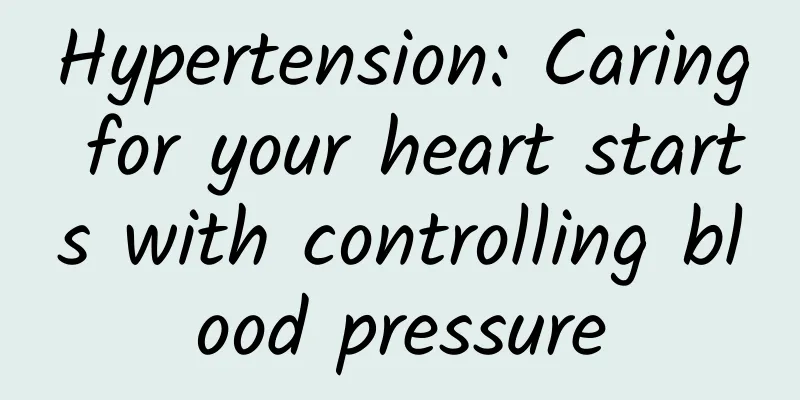Hypertension: Caring for your heart starts with controlling blood pressure

|
Author: Fan Yifan, Chief Physician, Beijing Chaoyang Hospital, Capital Medical University Reviewer: Zhao Lin, Chief Physician, Beijing Chaoyang Hospital, Capital Medical University October 8th is the 27th National Hypertension Day. In the fast-paced modern life, high blood pressure has become an invisible killer that threatens our heart health. If it is not controlled in time, it will quietly erode our blood vessels and gradually weaken the function of the heart. So, how does high blood pressure affect our heart health? Let's uncover the secrets between high blood pressure and the heart, and learn how to start by controlling blood pressure and caring for our hearts. Figure 1 Copyright image, no permission to reprint 1. Hypertension: the invisible burden on the heart Hypertension refers to excessive pressure exerted by blood on the blood vessel wall in the artery, usually measured at rest as systolic blood pressure (high pressure) ≥140mmHg and/or diastolic blood pressure (low pressure) ≥90mmHg. So, how does hypertension develop? Hypertension is divided into two categories: primary hypertension and secondary hypertension based on the cause and pathogenesis. Primary hypertension accounts for the vast majority of hypertensive patients and may be related to genetic, environmental and other factors. It usually requires long-term or even lifelong drug treatment and lifestyle intervention. Secondary hypertension is high blood pressure caused by certain specific diseases or causes. Common causes include chronic kidney disease, renal artery stenosis, primary aldosteronism, pheochromocytoma, etc., which require professional doctors to guide diagnosis and treatment. The focus of treatment is to remove or control the primary cause. Hypertension is called the "invisible killer" because it often has no obvious symptoms in the early stages. Many people may not discover that their blood pressure has quietly risen until they have a physical examination, just like a seemingly calm city, but in fact the internal traffic has fallen into chaos. This asymptomatic characteristic gives hypertension enough time to slowly erode our bodies, especially the heart. The persistent state of hypertension is like putting an invisible shackle on the heart, forcing it to bear an extra burden. In the long run, the heart will gradually be damaged due to overwork, resulting in serious consequences such as myocardial hypertrophy and heart failure. What's more serious is that hypertension is also an important risk factor for heart diseases such as coronary atherosclerotic heart disease (abbreviated as "coronary heart disease") and myocardial infarction. Therefore, we must attach great importance to hypertension, detect and control it as early as possible, so as not to cause irreversible damage to the heart. Figure 2 Copyright image, no permission to reprint 2. Hypertension and the “Symphony” of the Heart Long-term hypertension can cause damage to the heart and lead to changes in heart structure and function. Hypertension increases the pressure of blood on the blood vessel wall, and the heart needs to pump blood harder to maintain the body's blood circulation. In the early stages, the heart may cope with the high pressure burden through compensatory hypertrophy; but as the disease progresses, the heart will gradually lose its compensatory ability and develop serious consequences such as heart failure. At the same time, hypertension is one of the important risk factors for atherosclerosis. High-pressure blood flow impacts the blood vessel wall, damages vascular endothelial cells, promotes lipid deposition and thrombosis, leading to coronary heart disease, vascular stenosis or blockage affects the heart's blood supply, and in severe cases will lead to myocardial infarction and sudden cardiac death, which can be life-threatening. Hypertension can also cause increased left atrial pressure, left atrial remodeling, and activation of the renin-angiotensin system. These changes can cause abnormal cardiac electrophysiology and increase the risk of arrhythmias such as atrial fibrillation. Changes in the structure and function of the heart can also affect the stability of blood pressure. Pathologies such as myocardial hypertrophy and myocardial fibrosis can reduce the heart's contractile function, causing the heart's ability to pump blood to decrease, leading to lower blood pressure. Diseases such as valvular heart disease and aortic stenosis can lead to left ventricular ejection obstruction, which in turn causes increased blood pressure. In addition, arrhythmias such as atrial fibrillation and premature ventricular contractions (ventricular premature beats) can also affect the heart's pumping function, thereby affecting blood pressure. There is an inseparable connection between hypertension and the heart, but there is also a conflict between them. On the one hand, the heart is one of the direct victims of hypertension; on the other hand, changes in heart function can affect the stability of blood pressure. This complex relationship requires us to fully consider the factors of the heart when evaluating and treating hypertension, and to take targeted treatment measures. 3. Reasonable blood pressure control to protect the heart Scientific monitoring of blood pressure : It is recommended that adults measure their blood pressure at least once a year. For people with a family history of hypertension, obesity, smoking, drinking and other bad habits or those who have been diagnosed with hypertension, the frequency of testing should be increased. It is recommended to test once a month or a week. Regular monitoring of blood pressure can detect abnormal blood pressure early, so that preventive and treatment measures can be taken to reduce the occurrence of complications. For patients with confirmed hypertension, regular monitoring of blood pressure can evaluate the treatment effect, adjust the treatment plan in time, and ensure that blood pressure is effectively controlled. Regular physical examinations and assessments : In addition to monitoring blood pressure, patients with hypertension should also undergo electrocardiograms and cardiac ultrasounds to help doctors assess the patient's blood pressure control, heart structure and function, and whether there are other risk factors for cardiovascular disease. Hypertensive patients are advised to undergo a comprehensive physical examination at least once a year to monitor changes in their condition and adjust treatment plans. At the same time, people with high-risk factors should undergo regular physical examinations to promptly detect and intervene in potential cardiovascular disease risks. Figure 3 Copyright image, no permission to reprint Lifestyle intervention : Long-term lifestyle changes, including a healthy diet, proper exercise, mental adjustment, weight control, smoking cessation and alcohol restriction, can effectively lower blood pressure levels and reduce the burden on the heart. All hypertensive patients need lifestyle intervention, which is the cornerstone of hypertension treatment. Rational use of medication to control blood pressure : For some patients with hypertension, simple lifestyle adjustments may not be able to control blood pressure within the ideal range. At this time, drug treatment is particularly important. The doctor will develop a personalized treatment plan based on the patient's specific situation and use the medication accurately. Patients need to follow the doctor's advice, take antihypertensive drugs on time and in the right amount, and should not stop taking the drugs or change the dosage at will. At the same time, pay attention to the side effects and interactions of the drugs. If symptoms such as heart discomfort or abnormal blood pressure occur, you should seek medical attention in time to get professional diagnosis and treatment. Therefore, the "heart" of high blood pressure cannot be ignored. By understanding the harm of high blood pressure, understanding its close connection with the heart, and mastering scientific blood pressure control methods, we can effectively lower blood pressure levels, reduce the burden on the heart, and protect heart health. Let us work together to pay attention to the "heart" of high blood pressure and start to boost health by controlling blood pressure! |
>>: Intracranial aneurysm - Listen to the "bomb disposal expert"
Recommend
How to postpone aunt
Menstruation is a normal physiological phenomenon...
I found out I was pregnant because my lower abdomen was swollen.
Lower abdominal distension is a problem that many...
How many days of not defecating during pregnancy affects the fetus
Although pregnancy is a relatively special stage,...
How much does Chow Tai Fook's silver cat's claw lucky beads cost? How to match Chow Tai Fook's silver cat's claw pendant to look good
Chow Tai Fook's silver cat claw lucky beads a...
Can pregnant women drink milk tea in late stage
Milk tea shops usually mix tea and milk together,...
What foods can help treat pelvic inflammatory disease?
Pelvic inflammatory disease is a common gynecolog...
How can adults prevent the Norovirus, a "troublemaker" in the intestine? Please keep this guide!
Recently, a 70-year-old grandmother was admitted ...
Six months pregnant quarrel and yelling
I love quarreling with my father-in-law recently,...
What should I do if my breasts are sagging and soft?
For women who have given birth, breastfeeding wil...
Is moxibustion useful for uterine cold?
Many patients with uterine cold usually treat it ...
30-year-old women do this, it is very simple to have an ageless face
Skin care is a daily must for women. Everyone wan...
Is it easy to get killed by washing your hair first when taking a shower?
Popular saying: Bathing order: wash your face fir...
What is the cause of uterine bleeding?
The female reproductive organ is the uterus, but ...
Will emergency contraceptive pills still work after 24 hours?
In daily life, there are many types of emergency ...
How much weight do you gain during 5 months of pregnancy?
Weight gain during pregnancy has always been a to...









